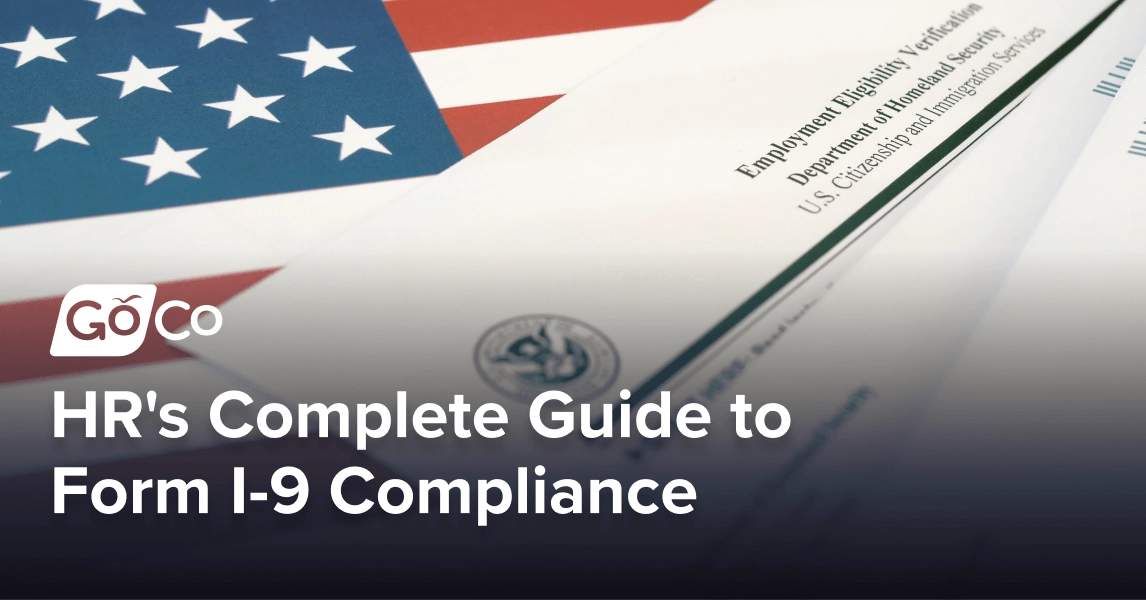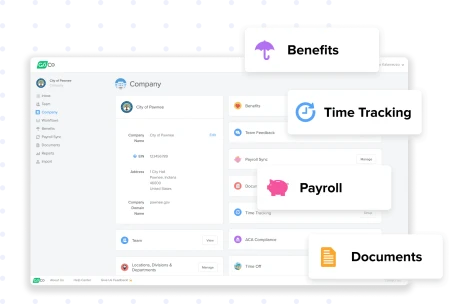HR's Complete Guide to Form I-9 Compliance
Everything you need to know about the Employment Eligibility Verification, I-9 Form in 2025
by Jennifer Kiesewetter - January 15th, 2025
Table of Contents
- What is an I-9 Form?
- What are the I-9 Form Requirements?
- Who is Required to Fill Out an I-9 Form?
- How Do I Send an I-9 Form to My Employee?
- What Documents Do I Need to Verify Employment Eligibility?
- What is E-Verify, and How Do I Do an E-Verify Check?
- How Do I Verify Employment Eligibility?
- How Can I Prevent Discrimination During the Employment Verification Process?
- What Are My Ongoing Responsibilities For Ensuring I-9 Compliance?
- Form I-9 Compliance FAQs
Do you find yourself lost amidst the changing requirements and complexities of Form I-9? In this comprehensive guide, we'll address all your burning questions about verifying employment eligibility and provide you with the clarity you've been seeking.
Download the FREE 2023 HR Compliance Calendar
Never miss an important compliance deadline again!
Check out our compliance guide to learn more about the I-9 and other HR compliance issues.
What is Form I-9 Used For?
The I-9 form is used by employers to “verify the identity and employment authorization” of employees in the United States. Workers must enter information about their identity and submit documentation that proves and supports their employment eligibility.
The employee must complete section one of the form, while the employer must fill out sections two and three. The USCIS website contains a guide for how to correctly fill out the entire document, which you can find here.
What are the Form I-9 Requirements?
Both employees and employers must fill out the I-9 form after the hiring process has been completed. Requirements for employees and employers are as follows:
Employers must have an I-9 on file for each eligible employee.
Employees must complete section one of the form no later than the first day of employment. This section should not be completed before a job offer has been accepted.
Employers must complete section two of the form within three days of the employee’s first day of employment. If the employee is hired for a period shorter than three days, section two must be completed no later than the first day of employment.
Spanish Version Requirements
Only employers and employees in Puerto Rico are permitted to complete the Spanish version of the I-9 form. Individuals from all other 50 states and U.S. territories must submit the English version of the form.
Who is Required to Fill Out a Form I-9?
The I-9 is only required for new employees, rehires, or those requiring re-verification. Existing employees who have completed valid I-9s are not required to resubmit the form simply due to the recent revisions.
Only those classified as employees are required to complete an I-9 form. It is easier to understand who is required to complete the I-9 form by outlining who is exempt.
For example, the following individuals are not required to complete an I-9:
Individuals employed for casual, domestic work. The work must be based in a private home and on a “sporadic, irregular, or intermittent basis.”
Independent contractors or individuals employed by a contractor providing contract services, such as temping agencies.
Individuals not physically working in the United States.
Employees hired on or before November 6, 1986, are not required to complete the form. In addition, employees based in the Commonwealth of the Northern Mariana Islands (CNMI) are not required to complete the form if they were hired on or before November 27, 2009.
How Do I Send a Form I-9 to My Employee?
There are two common methods for requesting an I-9 from an employee:
Option 1: Manually Print and Sign the Form
Provide a printed paper copy for the employee to sign. The new I-9 forms are available for download via the USCIS website.
Option 2: Pay For an e-Signature Solution
If you have an e-signature solution in place, you can upload and send I-9 forms for a fee.
What Documents Do I Need to Verify Employment Eligibility?
Employees must submit documents that prove their identity and authorization to work in the United States. Depending on their eligibility, employees may submit one document from List A or a combination of documents from Lists B and C.
List A Documents
These establish both identity and employment eligibility. Therefore, supplementary documents from List B or C are not required.
U.S. Passport or U.S. Passport Card
Permanent Resident Card or Alien Registration Receipt Card (Form I-551)
Foreign passport containing a Form I-551 stamp or Form I-551 printed notation
Employment Authorization Document Card (Form I-766)
Foreign passport with Form I-94 or Form I-94A with Arrival-Departure Record and containing an endorsement to work
Passport from the Federated States of Micronesia (FSM) or the Republic of the Marshall Islands (RMI) with Form I-94 or Form I-94A
List B Documents
These only establish identity. Therefore, documents that establish employment eligibility from List C must also be submitted.
Driver’s License or Identification Card. The card must be issued by a state or outlying territory of the United States and contain a photograph or information such as name, date of birth, gender, height, eye color, and address. Examples of acceptable cards are as follows:
ID card issued by federal, state, or local government agencies or entities, provided it contains a photograph or information such as name, date of birth, gender, height, eye color, and address.
School ID card with a photograph
Voter's registration card
Military ID card or draft record
Military dependent's ID card
U.S. Coast Guard Merchant Mariner Card
Native American tribal document
Canadian driver’s license
ID cards for minors under the age of 18 unable to present one of the above cards.```
School record or report card
Clinic, doctor, or hospital record
Daycare or nursery school record
List C Documents
These only establish employment eligibility. Therefore, documents that establish identity from List B must also be submitted.
U.S. Social Security account number card that is unrestricted
Consular Report of Birth Abroad (Form FS-240)
Certification of Birth Abroad issued by the U.S. Department of State (Form FS-545)
Certification of Report of Birth issued by the U.S. Department of State (Form DS-1350)
Original or certified copy of a birth certificate issued by a state, county, municipal authority, or outlying territory of the United States bearing an official seal
Native American tribal document
U.S. Citizen ID Card (Form I-197)
Identification Card for Use of Resident Citizen in the United States (Form I-179)
Employment authorization document issued by the Department of Homeland Security (DHS)
Expired Documents
Employees must present valid, original, and unexpired documents to employers. If an employee does not yet have the original copy of a newly ordered document, they may present an official receipt instead. Visit the USCIS website for more details on acceptable receipts.
What is E-Verify, and How Do I Do an E-Verify Check?
The E-Verify system helps employers confirm an employee’s employment status by matching the information provided against Department of Homeland Security (DHS) and Social Security Administration (SSA) records. For most employers, it is voluntary. However, certain employers are required to use it, such as federal contractors, those in states that mandate it, and those who have been ordered in a legal ruling to do so. In addition, once an E-Verify account has been opened, employers must use the system for all new employees.
Looking to streamline your E-Verify process? GoCo's modern platform allows you to directly integrate E-Verify into your HRIS, allowing you to stay organized, up-to-date, and compliant – all in one place.
Note: Employers must retain copies of any documents that require photo matching, such as a passport or driver’s license.
How Do I Verify Employment Eligibility?
Employers are required to verify the submitted documents by determining whether they “reasonably appear to be genuine.” If a document does not appear to be valid, an employer can reject it and ask for valid alternatives.
Re-verification
Employers can re-verify an employee’s status by completing section three on the form. This section must be completed if the employment authorization or employment authorization documents have expired. Employers may — but are not required to — complete section three if the employee has been rehired within three years of the first I-9 being completed or legally changed their name during this time. Visit the USCIS website for more details on re-verification.
Employers may request an authorized individual, such as a “personnel officer, foreman, agent, or notary public” to complete section two or three on behalf of the company. No official documentation is needed to allocate an authorized person. However, the employer is liable for any errors or illegal actions taken by the authorized individual during the verification process. In all cases, the individual reviewing the employee’s employment verification documents must do so in person and be the same individual who completes the form.
In California, the authorized representative must be certified and bonded as an immigration consultant to verify I-9 documents. This also applies to notary publics.
How Can I Prevent Discrimination During the Employment Verification Process?
The Immigration and Nationality Act prohibits employers from discriminating against an employee during the hiring, firing, or verification process based on citizenship, immigration status, or nation of origin. Therefore, in compliance with the law, employers cannot:
Ask to see employment authorization documents before a job offer has been accepted;
Refuse to accept documents or hire individuals because their employment authorization will expire in the future;
Refuse an acceptable receipt of an authorized document; or
Request or suggest specific documents from the employee.
If an employee experiences discrimination, they can file a claim with the Immigrant and Employee Rights Section (IER). Employers cannot retaliate if an employee files a charge, participates in an investigation, or attests to their rights. Visit the USCIS website for more details on the laws surrounding employment discrimination.
What Are My Ongoing Responsibilities For Ensuring Form I-9 Compliance?
Employers must comply with the rules outlined by the USCIS when retaining, storing, and updating I-9 forms. Employers must meet the following responsibilities:
Retaining – Employers must retain valid I-9 forms for all eligible employees for three years or one year after employment has terminated, whichever is later. Only the part of the form containing the employee and employer data must be kept.
Storing – Forms can be stored on paper, microfilm, microfiche, or electronically. Forms must be made available to the Department of Homeland Security, Department of Labor, or Department of Justice within three days of a request.
Updating – It is the employer’s responsibility to keep track of expiration dates and reverify an employee if required. The employer must initial and date any corrections made to the form.
Employers who fail to maintain valid I-9 forms or illegally discriminate against new hires may be subject to fines, debarment, court orders, and criminal penalties.
Form I-9 Compliance FAQs
-
No. All documents must be original, except for certified copies of birth certificates and authorized receipts.
-
Not directly; however, the law states that no employer shall “hire, recruit for a fee, or refer for a fee unauthorized aliens they know to be unauthorized to work in the U.S.” Therefore, it is advisable to be diligent when hiring both employees and independent contractors and ensure all parties connected with your business are eligible to work within the United States.
-
Yes. An I-9 form must be completed for all employees, regardless of employment length.
-
You can fire an employee within three days of the start of employment if he or she does not submit the correct paperwork.
The USCIS website has a full list of FAQs for employees and employers completing the I-9 form.
Updated 1/15/2025

Subscribe to Beyond The Desk to get insights, important dates, and a healthy dose of HR fun straight to your inbox.
Subscribe hereRecommended Posts
2025 Employee Onboarding Checklist [3 Easy Phases]
Blog Articles
The State of Health & Safety In HR Report
Blog Articles
Search...
Product
GoCo
Resources
Articles
eBooks
Webinars
Customer Stories





